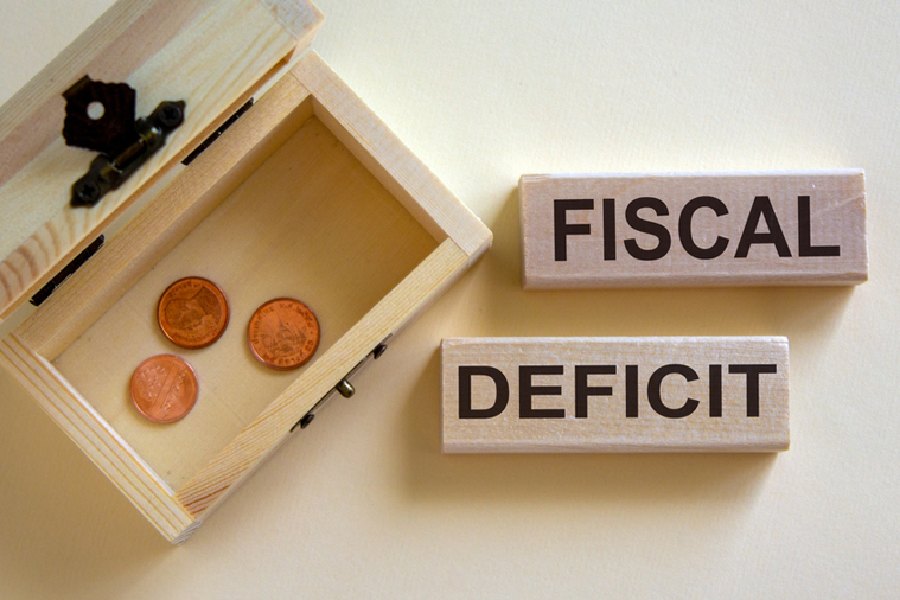A revised estimate of the fiscal deficit at 5.8 per cent of GDP in the current financial year (2023-24) — as against a budget projection of 5.9 per cent — coupled with a reassertion that the economy was firmly on the path of fiscal consolidation that would eventually bring down the number to 4.5 per cent of GDP by 2025-26, were the two major takeaways of the interim budget that finance minister Nirmala Sitharaman presented in Parliament on Thursday.
The market borrowing requirements of the government, which it needs to bridge the gap between its receipts and expenditure, would be less than that in 2023-24, she added, drawing applause from the fiscal purists who have been expressing concerns over the rising outgo on account of interest payments and debt servicing.
Given the accumulated debt burden on the Central government, expected to be Rs 172.37 lakh crore or over 58 per cent of current GDP in end-March 2024, there is little doubt that it has become a ticking time bomb. With the Congress-led opposition expressing concerns over rising public debt in recent times, the Finance Minister has chosen to address the problem.
Sitharaman also claimed that the Narendra Modi government has put the economy firmly on a high and sustainable growth path with all-round development. She also promised that a White Paper on how the economy was mismanaged before 2014 would be tabled in Parliament for the purpose of drawing lessons.
Course correction is indeed an important part of policymaking and Sitharaman cannot be faulted for her attempts to identify the mistakes made in the past so that they are not repeated. Using a similar logic, the budget numbers presented by her also merit closer scrutiny.
The high point of Sitharaman’s last budget was the increase in capital expenditure by 33 per cent to reach Rs 10 lakh crore, estimated around 3.3 per cent of GDP. The big story of the budget, she had said last year, was the direct capital investment by the Centre, which would be complemented by the provision made for the creation of capital assets through grants-in aid to the states. This would push up the effective capital expenditure to Rs 13.7 lakh crore, around 4.5 per cent of the GDP.
A reality check reveals that Sitharaman has cut down on capex in the current financial year from Rs 10,00,961 crore (BE) to Rs 9,50,246 crore (RE) while she has spent more than the budget estimates under heads like defence and food and fertiliser subsidies. This is how a lower fiscal deficit is being achieved in 2023-24.
In the quest for fiscal space, the finance ministry Babus have not only opted to slash capex, they have also indulged in some accounting tricks, which can be seen in a “backloading” of current financial year’s interest outgo on to the next financial year. There is a significant drop in outgo on account of interest payments and debt servicing for 2023-24 by Rs 24,544 crore, while the budget estimate under the same head for the next fiscal is Rs 1,35,013 crore more than the revised estimate of the current fiscal.
As the finance minister has set a target to bring down the fiscal deficit to 5.1 per cent of GDP by 2024-25, doubts can be raised on whether she can achieve the goal without slashing capital and welfare expenditure.
The government seems to be relying on the Indian growth story — according to first advance estimates, the growth in real GDP in 2023-24 is estimated at 7.3 per cent — to argue that the deficit target is achievable as higher growth will generate higher revenue receipts, enough to take care of the expenditure commitments.
There are problems with the growth story though.
First, the nominal GDP for 2023-24, which was projected in last year’s budget at Rs 301,75,065 crore, has come down to Rs 296,57,745 crore in the First Advance Estimates.
Then there are concerns about the veracity of the numbers. Questions are being asked that if nominal GDP growth is only 8.9 per cent in 2023-24, can real GDP be growing at 7.3 per cent? Former Chief Economic Advisor Arvind Subramanian, among many others, have publicly reflected on the overestimation of India’s real GDP growth, because of a faulty GDP deflator. The International Monetary Fund (IMF) has also raised several issues with India’s official data on GDP, inflation and employment.
Whether Sitharaman’s fiscal consolidation roadmap would finally materialise over the next two years, would depend much upon what transpires to the real GDP growth story for India, in real time.











